Kokubura Campaign Setting
Kokubura: The Little Dragon
All maps below are clickable bitmaps. To see the description of an area, simply click on it.
| Kainuik Wastelands |
|
| Takara Ken | |
| Miusha (Wastelands) | |
| Makura | |
| Waka-to |
Maps: Campaign Cartographer Maps of Kokubura, Village Korobubaru (on island Makura), and a typical building of the Temple Makura sect. A free Campaign cartographer viewer can be found here.
Kainuik Wastelands

By the rest of Kokubura's standards, Kainuik is truly a wasteland. By its inhabitants' ken, it's the resting place of a god.
The Kainuik Wastelands lie mostly within a marshy valley on the northern tip of Kokubura. The most notable inhabitants are tribes of bakemono and korobokuru, though the two are stalwart enemies of one another.
Regional Feats: Chaer' Run Warrior Training (Korobokuru tribe members from the Valley), Clan Provider (Korobokuru tribe members from the Valley), Guiding (Korobokuru tribe members from the Valley or The Valley of the Three Elk), Mountain Hermit (Sheng Mountains, Myo Sheng Mountains), Superior Chaer' Run Warrior Training (Korobokuru tribe members from the Valley), Aura of Mystique (Shefu), Wolf Handling (Korobokuru tribe members from the Valley or The Valley of the Three Elk)
Prestige classes associated with the Kainuik Wastelands: Chaer' Run Elite Warrior (Korobokuru tribe members), Bear Warrior (Korobokuru tribe members, Oriental Adventures), Kainuik Wolf Rider (Korobokuru tribe members), Battle Maiden (female Korobokuru of Tribe Yoroke, Oriental Adventures)
Climate and geography The Kainuik's geography is fairly simple - to the northeast runs a small sliver of mountains called the Myo Sheng, and to the southwest and south greater peaks simply called the Sheng. Between them lies what is known as "the wastelands," though several tribes of korobokuru and others make it home. The fact that its marshes are uneasy traveling seems to expand the wastelands beyond their actual aerial extent - two wagwums (itinerant native villages) may be only a few miles apart yet never trade visitors for the trouble of it all. In the center of it all meanders the Karog river, a slow watercourse that drains the wastelands and serves as conduit for kayaks in the summer and walkers in winter (the Karog freezes over from Oct-seng to Ap-seng).
 At the lower end of Myo Sheng stands a mighty peak known to the barbarian
tribes as Marok's Chin, referring to a god who figured prominently in ancient
legends. It is said that Marok fought the powers that would set the sky alight
(and lost, point out proselytizing priests from the rest of Kokuburu). When he
finally lay to rest, his great chin came to lay where the mountain bearing it's
mythic namesake now lies.
At the lower end of Myo Sheng stands a mighty peak known to the barbarian
tribes as Marok's Chin, referring to a god who figured prominently in ancient
legends. It is said that Marok fought the powers that would set the sky alight
(and lost, point out proselytizing priests from the rest of Kokuburu). When he
finally lay to rest, his great chin came to lay where the mountain bearing it's
mythic namesake now lies.
Across the valley, nearly 150 miles away, thrusts from the valley floor Marok's toe - another gigantic slab of rock that purportedly marks where Marok stood in the final battle. Both sites are regarded as sacred by the tribes inhabiting the valley floor. Every 50 years a tribe elder and entourage will travel to one of the peaks and then the other (though which peak is first depends on the tribe). When the two groups of pilgrims meet in the valley midway between their respective destinations, it is a time of celebration and personal challenges, enough to make any barbarian happy.
The Kainuik is not kind in winter - the great wall formed by the Sheng peaks blocks most of the warm air coming from the south, and a fierce wind hales down the valley from the north. The Karog river freezes over, and many wagwums dig deep into their store of tubers and smoked meats to survive. Summer is the opposite - a swarming mass of insects buzzes over the marshlands, driven away only by great pyres of smoldering grasses the wagwums keep burning.
Politics The korobokuru are rarely united as a political unit - the closest thing that comes to any sort of consensus between the tribes is when to start the pilgrimage to Marok's mountains every 50 years. Partly this is due to the trouble of travel across the marshy wastes. This is probably a good thing for those south of Kainuik, as any leader able to forge a unified community among the tribes could release their full fury against the province of Arigyou-Ta, leaving nothing between them and the Tourmaline Throne.
Inhabitants While a few human tribes eek out an existence in this bitter land - many of them fishing villages on the northern coast - most inhabitants are not human. Korobokuru, bakemono, and earth kala (magical humanoids inured to cold) wander the great valley. In the hills and mountains, shan sao (a secretive and fearless race of one-foot tall humanoids) and some goblinoids also take up residence.
Legends also tell of a squat gargantua that roamed the valley in times long past. Where it or its ancestors went only Marok knows.
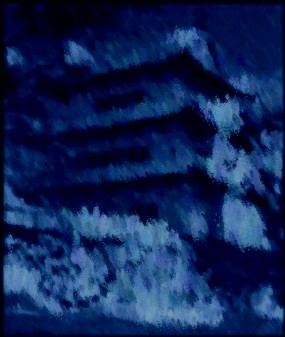 Sefa
Sefa
On the northeastern edge of the Kainuik prefecture, standing high on an outcropping from the Myo Sheng mountains, stands an ancient tower. While the korobokuru know of the fortress, they can say little, as any brave souls who ever ventured that way failed to return. "Ask the kala," they say. And in turn, the kala refuse to discuss the place, whispering that it hold dark secrets for anyone who speaks of it aloud. Whether abandoned or inhabited, tower of a wu jen or warlord, no one knows. Characters that come from here and can convince an audience of this can earn the Aura of Mystique feat.
Sefa
Population: 3,180
Racial mix: Korobokuru 90%, Human 8%, other 2%
Alignment: Neutral
Valley of the Three Elk
This is the southeastern area of the Kainuik wastelands, and although it is not so marshy as the rest of the province, it certainly rivals it in barrenness. Only a few tribes wander here on account of the lack of game (thus, the name - you're blessed if you see a total of three elk during the whole of a winter, natives say).
The Valley
"The Valley" refers to the marshy areas between the Sheng and Myo Sheng mountains drained by the River Karog. While there are plenty of inhabitants between these two ranges, it is difficult to discuss any single one on account of the tribes' constant itinerancy. Indeed, the only time they seem to be in a predictable place is during the winter, when most tribes move near the Karog in order to extend their winter stores with fish caught from beneath the ice.
Nevertheless, it is possible to name a few of the more prominent tribes of korobokuru and the few humans that reside in the area.
Kainuik Clan This tribe of korobokuru claims to be the "father" tribe of them all, though others are certainly more populous and at times more powerful. Kainuik Clan warriors sometimes take to riding wolves as mounts when they can catch and tame them. Kainuik Clan can often be found near one of the sacred Marok mountains. Many members of this tribe have earned the Wolf Handling feat.
Ma'keer A mixed community of korobokuru and humans, Ma'keer relocates every few years to a better fishing spot along the northern coast. For many travelers coming to the Kainuik Wastelands, this village is the first contact they make, as the trip is so often made by boat rather than the overland journey from the south. Though not a "permanent" community, Ma'keer serves as a useful venturing point for those having business within the Kainuik. Basic services and even a small smithy are available in Ma'keer, wherever it may be.
Chaer' Ran Korobokuru are not known for their Wisdom. Even so, this tribe prides itself in making its warriors stronger by pounding them on the head anvils they make from spare wood and rocks taken from the mountains. Known as the "flatheads" by the rest of the tribes, a Chaer Ran warrior is nevertheless known for his fierceness in battle, and seeming inability to be phased by even the gravest injury. "No brain, no pain." This tribe can be found almost anywhere within the Wastelands. The best of the warriors ar known to have the Chaer' Run Warrior Training and Superior Chaer' Run Warrior Training feats, and have levels in the Chaer' Ran Elite Warrior prestige class.
Yoroke Clan This clan is known as one of the more prominent that have a matrilineal form of ruler ship. Their females are known to be as adept in battle as the men are at watching the little ones. Yoroke Clan tends to wander the area east of the Karog river. Female korobokuru from this tribe sometimes have levels in the Battle Maiden prestige class (Oriental Adventures), though they prefer riding trained wolves over horses, and often have the Wolf Handling feat.
Takara Ken
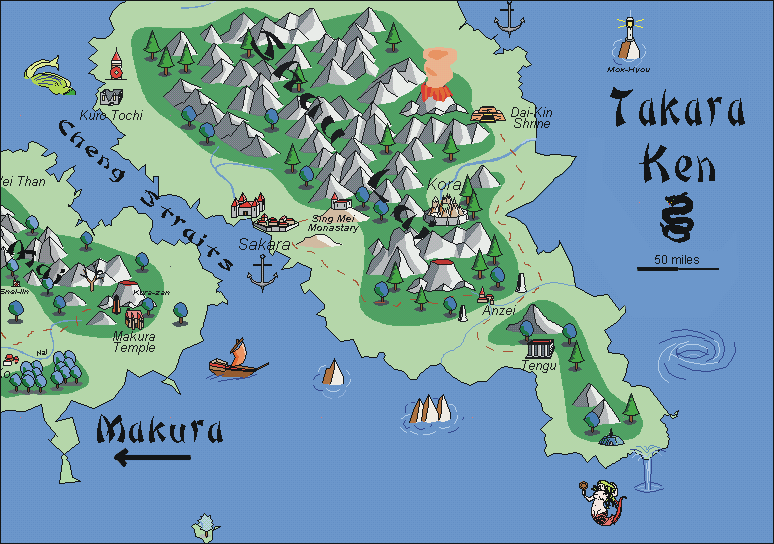
The name of this prefecture obtained its name from the high expectations early human settlers had of its mountains. Though not entirely displeased, the rocks were more forbidden than they hoped for - even today, tengu, oni, and other fearsome creatures wander the heights of the Shau Lai Mountains. There is even rumored to be a forgotten valley where everything - animals, trees, even the humans - are miniature yet skilled in the arts of sorcery.
Regional feats Aura of Mystique (Tengu), Mountain Hermit (Shau Lai Mountains)
Prestige classes associated with Takara Ken Tatooed monk (Sing Mei Monastary), Sumotori (sumo wrestlers of Sakara), Foe Hunter (elite garrison of Anzei)
Climate & Geography The Shau Lai mountain range extends near the entire length of Takara Ken, and is composed of a long stretch of wooded peaks with the occasional rocky summit. Weather in Takara Ken is noticeably different between the side facing the Cheng Straits and the other half across the mountains. The former is known for its fierce storms coming in off the sea any time of the year; and the latter has relatively mild weather the year round.
At the southern end of Takara-ken swirl great whirlpools. Few ships venturing near them have safely returned, though a helpful sea dragon has aided doomed boats from time to time. Most shipping from the mainland and western Kokubura comes around the northern end or travels all the way to Daibake Jima (though no sailor willingly lands there, of course).
Politics Power in Takara Ken revolves around two sources - the deputy of the shogunate positioned in Sakara, and the independent authority residing in Kora. While the history of Kora is well known among those in Kokubura, its present state is very mysterious. There is no official contact with the city, and very few merchants travel there. There are rumors that a malign influence has taken hold of the city, magically encasing it in charms and enchantments, though this is likely more talk than truth. Despite the lack of interaction, Sakara has little trust for its mysterious neighbor. The daimyo of Sakara maintains a standing force and regularly drills them in the defense of the city.
Religious authorities tend not to be as powerful and involved in politics in Takara as they are elsewhere. Nevertheless, Sing Mei monastery, overlooking Sakara, occasionally exercises political favors in the region.
Nonhuman Folk Humanoid "kingdoms" abound in the Shau Lai mountain range. Bugbears, goblin rats, and plenty of bakemono are commonly found, while there are reputedly communities of tengu and oni. There is also a reputed valley, difficult to enter and even more so to leave, that serves as an entire nation to diminutive flora and fauna, complete with towns of six-inch humans.
While there are quite a few human towns scattered throughout the area, almost all are under the auspices of a spirit or other powerful creature. Some pay reverence to a do cuo'c, others enjoy the protection of a guardian naga. Nevertheless, there are a few villages "cared for" by evil spirits whose presence keeps out intruders, although the townsfolk themselves suffer under their tyrannical rule.
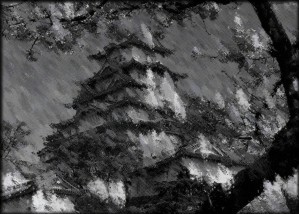 Sakara
Sakara
Provincial capitol, Sakara serves as the seat of the ruling daimyo. Though this position includes the eastern half of Takara as well, in modern times the daimyo has only been able to extend his control along the western seaboard at best.
Sakara is known for its spacious and placid port. In fact, the city was long plagued by rampant typhoons, but in an age past the daimyo had a powerful enchantment placed on the harbor, making its waters ever calm. While this has greatly benefited trade and fishing in the area, it has had unforeseen consequences of late. A series of strange ships propelled seemingly only by magic appeared on the horizon one day. Immediately upon entering the harbor, the ships sank however. Upon investigation, agents of the daimyo found the ships at the bottom of the sea with not a sign of (drowned) life aboard them.
Sumo is a popular sport in Sakara, and some say it was here that daimyo Myoshi Teyori challenged an obstinate oni to a match, threw his opponent down on the beach breaking his hip, and thus began the sport (and the province). Elite sumotori take levels in the prestige class of the same name.
Historically, Sakara has been subject to a great many raids by humanoid kingdoms coming out of the mountains. Ironically, these raiders are sometimes helped by less trustworthy residents of the city. Thus, residents of Sakara are eligible to take the Easy Listening feat.
Sakara
Population: 12, 480
Racial Mix: 88% human, 10% hengeyokai, 2% other
Alignment: Lawful neutral
Sing Mei Monastery
Sing Mei Monastery and Sakara were actually founded at the same time. While initially rivals, persistent attacks by monsters coming down from the mountains have pushed them into each others' arms, and Sing Mei and the Sakara daimyo enjoy an alliance now several centuries old. Sing Mei is known for its practice of an austere form of martial arts.
Monks of Sing Mei are known for their colorful tatooes, which some can invoke to produce magical effects. A practicioner of Sing Mei can thus take levels of the tatooed monk prestige class (Oriental Adventures).
Sing Mei Monastery
Population: 1,870
Racial Mix: Human 75%, Bamboo Spirit Folk 12%, Vanara 12%, Other 6%
Alignment: Lawful good
Kuro Tochi
Ruins on the north end of the Cheng Straits, this mysterious dwelling is said to have been founded seven centuries ago. At that time, an emperor from the mainland had a vision that a flower granting immortality could be found by across the sea - and that this flower could only be located by children. The emperor set forth boatloads of children, none of whom ever returned. One ship however was found by a sympathetic spirit of the sea, and guided to the empty coast of Kokubura, and their descendants now inhabit Kuro Tochi.
The oddest part of this area is not its founding, but the ancient ward placed on it by that guardian sea spirit. Close to the center - where the ship touched land - distances are extended beyond what they seem. A trip that would take one day takes three, and neighbors seemingly living close together live far apart when the traveling time between their dwellings is noted.
Only a few inhabitants of Kuro Tochi speak Kokubura. All speak their own dialect of the mainland tongue.
Distances Any distance-based phenomenon is reduced when within 20 miles of Kuro-tochi. This means that weapon ranges, movement rates, spell ranges, and so on are cut by one-third. When within 10 miles, all distances effects are reduced by half, and when in the town itself, all distances are cut by two-thirds%. For example, a daikyu (composite longbow) has normal range increment of 110 feet. When shot within 20 miles of the town, the range increment is 70 feet. When within 10 miles, the increment is 55 feet, and if shot in the town proper, the range increment is 35 feet. 5' adjustment steps are not allowed within the town during combat, though any character can move at least 5' per round if she takes a move-equivalent action to actually move.
Kuro-tochi
Population: 2, 420
Racial Mix: 99% sea spirit folk, 1% other
Alignment: Neutral
Anzei
Named "safety," this small redoubt serves as the guard force that keeps the only pass of the Shou Lai mountains open. At times, even it has been overrun by monstrous forces, shutting off Sakara from the capitol. If it weren't for the whirlpools that trouble ships rounding the tip of Takara-ken, this route would be all near uneconomical. As it is, the pass is so important that both Sakara and Sing Mei Monastery keep a standing and able force here.
Also of note are the two stone obelisks that mark either end of the pass. Shaman commissioned by Sakara have enchanted these gigantic outcroppings of natural rock to act in a way as guardians for travelers making their way through the pass. Any being making an offering to the first rock it passes gains a +2 divine bonus to Spot and Listen checks while on the road. This bonus ends when the other obelisk is passed. It is rumored that more powerful enchantments reside within the rocks, ones that would call them to life in dire need.
Among the monsters that haunt the pass, there are a plethora of oni, bakemono, and even a few small armies led by dark naga. Elite members of the garrison are known for their ability to hunt down these enemies, and thus are have levels in the Foe Hunter prestige class.
Anzei
Population: 800
Racial mix: Human 85%, vanara 5%, other 10%
Alignment: Lawful neutral
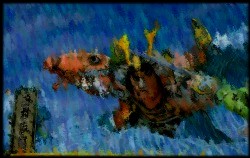 Tengu
Tengu
This mysterious temple complex has been visited by few humans, though the ones that go there seem always welcome. As per the name, almost the entire population is composed of tengu. The inhabitants teach an intricate philosophy and practicing mastery of the katana. Though visiting is not encouraged, none are turned away if they follow the temple's strict codes. Most "foreigners" that frequent the place are merchants from Sakara and elsewhere.
Residents of Tengu can take the Aura of Mystique feat, on account of their unusual acquaintance.
Tengu
Population: 2,350
Racial mix: Crow-headed tengu 78%, human-headed tengu 14%, vanara 4%, nezumi 2%, other 2%
Alignment: Lawful neutral
Dai-Kin Shrine
Dedicated to the massive powers of nearby volcanic Dai-Kin-zan, this religious institution serves as a mainstay against the increasing unruliness of Kora. Imperial shinobi report that several of the abbey are already taking orders from Kora however, and so it is not known how much longer Dai-Kin will remain independent. There is a large faction who are open in their rejection of their southern neighbor, and if things continue as they are, it would not be impossible for them to break off and form their own temple elsewhere.
Among the philosophic riches of Dai-Kin, the temple also boasts a mine that burrows deep into Dai-Kin-zan. Weapons and metallic armors forged of metals mines from here are treated as if they were masterwork. Additionally, several isolated pockets of adamantine have been discovered in the volcano's fiery depths. Perhaps Kora's interest in the area is justified.
Dai-Kin Shrine
Population: 7,790
Racial mix: Human 70%, Earth genasi 15%, Fire genasi 7%, other 8%
Alignment: Lawful neutral (becoming Chaotic neutral).
 Kora
Kora
Revealed in a cataclysmic eruption of nearby Shou-Lei-zan, the existence of Kora was revealed to the rest of Kokubura several centuries ago. Indeed, it is all but independent of Kokubura and swears no fealty to the Tourmaline throne. And though the emperor would like to pull the city into his fold, it will take more might than the Imperial army can muster. Kora is a threat to be wary of.
Founded at the headwaters of the Shiwei, which runs directly to the coast, the rulers of Kora now draw their power directly from the earth where the waters spring forth. Somehow bending the river to their desires, their powers have caused the Shiwei to run foul, all the way to the coast.
It is rumored that Kora has forged alliances with several of the monster kingdoms in the Shau Lai mountain range, either through diplomacy or subjugation. What plans its rulers have are unknown and a great cause of concern to the Tourmaline Throne.
Fearsome and skilled warriors known as "blade dancers" (Oriental Adventures) have claimed allegiance to Kora.
Kora
Population: 44,400
Racial mix: Human 50%, nezumi 15%, river spirit folk 10%, humanoid 20%, other 5%
Alignment: Chaotic neutral
Miusha (Wetlands)
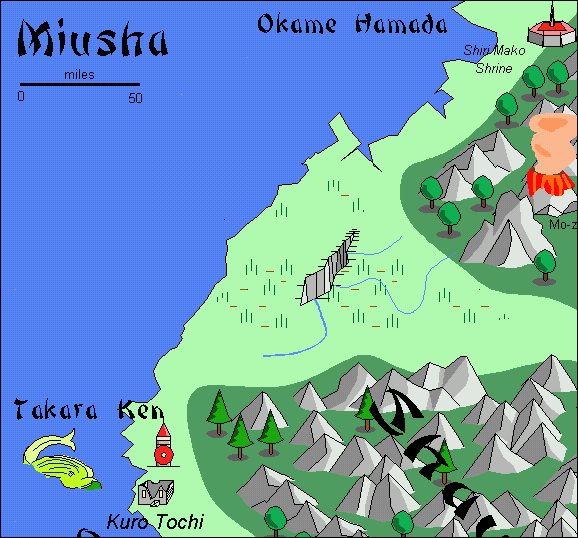 Miusha was once the site of a kingdom of chaos, one founded before settlers
from the mainland arrived. It was during Kokubura no Kibo (the war
between lawful and chaotic spirits) that the city was
destroyed by a great tsunami called forth from the ocean. Washing the evil away,
it left the swamp now called Miusha, as was the kingdom.
Miusha was once the site of a kingdom of chaos, one founded before settlers
from the mainland arrived. It was during Kokubura no Kibo (the war
between lawful and chaotic spirits) that the city was
destroyed by a great tsunami called forth from the ocean. Washing the evil away,
it left the swamp now called Miusha, as was the kingdom.
Unlike most swamps, this one is fairly inviting… travelers who have lost their way find themselves guests at the houses of beneficial spirits who live in the ruins of the lost kingdom. Nevertheless, a few tell of pockets of evil hidden within the swamp, and some have been called upon by their hosts to enter these areas and empty them of their foul influence - apparently spirits cannot even approach these sites. What is frightening is reports of these places of evil expanding their malicious grasp over the land.
At the center of the ruined kingdom lies a deep crevasse, one seen known only from divinations, as those who venture to its edge have become blind. The spirits say it was created when the kingdom finally fell, and sucked into the bowels of the earth. Whether the kingdom Miusha is really dead or not remains to be seen.
Regional feats: Aura of Mystique, Forlorn
Prestige classes associated with Miusha Though found in any wilderness area of Kokobura, the inja of Miusha are reknowned.
Makura
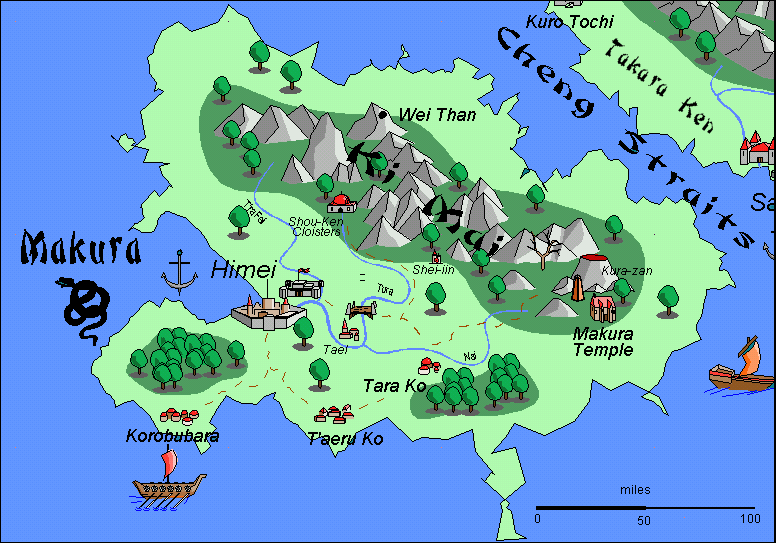
- Himei (Capitol)
- Tael
- Shei-iin
- Korobubaru, T'aeru Ko, and Tara Ko
- Shou-Ken Cloisters
- Temple Makura
- Wei Than
- Encounter Tables
Makura is the second largest island of Kokubura and lies off the southern coast of the Kokubura proper. It is thought that the ancestral Kokubura-jin first came from this island, as the goddess Izanarami set fire to the heavens, burning away all but the stars and revealing the land of The Little Dragon.
At present most Makurese go about their daily lives worrying about what most of people of Wa worry about - the next harvest, vengeful spirits, and pesky goblins. There is indeed plenty for the adventurer to do, and quite a few renowned sword-wielders have come from Makura.
Regional Feats: Aura of Mystique (Wei Than), Easy Listening (Himei), Shou-Ken "Flight" (Shou-Ken Cloisters), Makuran Fire-Walking (Temple Makura), Tael's Blessing (Tael), Wako (Korobubara, T'aeru Ko, Tara Ko), Mountain Hermit (Ki Mai Mountains)
Prestige classes associated with Makura Makuran Fire Walker (warrior of Temple Makura), Shinsei (Shou Ken sohei/psionic warrior), Shinkage (Shou Ken psionic ninja), Hida Defenders (members of the Himei daimyo's emite force)
Climate and geography Owing to its small size, most of Makura shares the same patterns of weather. Hot and steamy in the summer, Kokubura's rainfall feeds its rivers which wash out from the base of the Ki Mai mountain range. Winters allow a little more mercy, chilling but only rarely yielding snow. The west side of the Ki Mai are somewhat cooler and drier however, but very few of the civilized live there anyway. Typhoons usually strike in the fall.
Politics Politically, the powers shaping human affairs in Makura are roughly shared between the provincial capital, Himei, and two temple complexes, the Shou-Ken Cloisters and Makura Temple near the base of volcanic Kura-zan in the south. Additionally, rumors in high court (and whispers in abbey's ears) suggest a hermit fiefdom centered about the little-known Wei Than in the northern part of the island's mountains may have influence beyond what its isolation suggests.
Pirates While Himei and the temples rally their forces against one another, at least two small towns on the southern coast suffer wako (pirate) raids almost annually. It underscores the inability of any human master to completely claim the island when such raiders take with ease and yet camp a little way off in the archipelago of Waka-To. Some even say the pirates are sponsored by at least one of the religious institutions on the island as a way to demonstrate to the people how ineffective their regional government is.
Nonhuman folk A fair population of hengeyokai and spirit folk thrive in the Ki Mai range, the set of mountains forming Makura's spine. The latter occasionally form alliances with the larger samurai houses in Himei or one (or both) of the main temples. As far as anyone has been able to ascertain however, non-human folk know as much about the mysterious Wei Than as anyone else.
At least one small community of tengu has been reported to exist in the Ki Mai. Goblinoids seem to thrive nearly everywhere in Makura. Indeed, the collapse of an ill-commissioned bridge in Himei a few years ago opened up an unknown cavern complex inhabited by hundreds of some of the nastiest creatures ever seen - all beneath the very feet of the Makura daimyo.
 Himei
Himei
Himei is the provincial capital of Makura. Rebuilt at least seven times in the last four centuries as a result of the constant wars between the daimyo and Shou-Ken Cloister and Makura Temple, Himei is nonetheless a bustling city for its size.
Its main asset is a deep harbor often visited by trading vessels from the mainland. While technically foreigners are not allowed to set foot in Kokubura, Makura is far enough away from the shogun's seat that it matters little. Indeed, many religious institutions had their first adherents appear in Himei, the founders having ventured aboard ships and disembarked onto this hungry land.
Like most cities in Kokubura, Himei is a walled town further split by wards, which themselves are divided by walls. Guards often accost those passing from one ward to the next, although such rough practices ultimately succeed in reducing rowdy types.
The elite members of the daimyo's army are known to be Hida Defenders (Oriental Adventures). Yakuza (Oriental Adventures) are also known to have a notable following in Himei. Many of the populace have the Easy Listening feat as a result of living in such a volatile city.
Encounter Table for Himei, Day | Encounter Table for Himei, Night
Himei
Population: 12,450
Racial mix: Isolated (80% human, 6% hengeyokai, 6% nezumi, 4% vanara, 2% spirit folk, 1% korobokuru, 1% other)
Power center: Conventional (Himei daimyo, lawful evil)
Authorities:
Daimyo of Makura: Totomi Hidetaka, human male, Samurai 12/Hida Defender 4, LE
Constable: Matura Shi, Fighter 14, human male, LE
Constable of the Western Ward: Totomi Himu, human male, Samurai 7/Hida defender 2, LN
Constable of the Castle Ward: Totomi Sada, human female, Fighter 8/Shugenja 3 (Air), LG
Constable of the Harbor: Merada Katoya, female sea spirit folk, Warrior 6, LN
Constable of the Southern Ward: Wei Fan, female dog hengeyokai, Wu jen 7, CG
64 full-time guards (Warrior 2), able to conscript 645 more for duty
Notable NPCs:
Meght, male, korobokuru, Barbarian 6, CG
Shaya T'ra, female, Fighter 7, N
Moro, female human, Samurai 7/ Weapon Master 3 (katana), LG
Torotomu (Shewa Jo), female monkey hengeyokai, Rogue 5/Wu jen 1/Monk 1, LE
Muhara Oma, female human, Shugenja 4, LE
Shihamu, male human, Shaman 9, NE (Worships Amatsu-Mikaboshi, the August Star of Heaven; Domains: Evil, Death)
Toma, dog hengeyokai, Shaman 4, NG (Worships Inari, God of Rice; Domains: Healing, Water)
Makura Shohai-ten, human male, Sohei 5/Rogue 5 (Devotee of Makura Temple), LE
Shen, human female, Wu jen 4, N
Mudin Jei, human female, Rogue 6/Yakuza 5, CG
Mudin Wal, human male, Rogue 6/Yakuza 3/Fighter 1, N
"Kaeru" (meaning "frog"), human male, Adept 6, NG
Taeniwa Machi, human, male, Aristocrat 7, N
Shin "Kiki", human male, Commoner 14, N
Ude, human male, Expert 10 (weaponsmithing), LE
Makosu, human female, Expert 5 (armorsmithing), LG
Fen Mou, human male (from mainland), Expert 6 (sailor)/Warrior 2, NE
Hakara, human female, Warrior 8, CE
Tael
Tael, which supposedly received its name from a monk new to Kokubura who was
trying to find where he could exchange tael (the money), is a small village
outside of Himei. While its strategic importance is not so essential, it has
miraculously been let alone by the samurai and sohei armies that seem almost
regularly to pass through as they go to make war on one another. It is said a
strong curse guards the place, and any who plunder between the waters (Tael is
surrounded on three sides by the winding Tora and Nai rivers) will suffer
misfortune unrivaled.
Only true natives of Tael - that is, persons actually born in Tael - can take the Tael's Blessing regional feat.
Tael
Population: 5,220
Racial mix: 80% human, 20% vanara
Alignment: Lawful neutral
Shei-iin
This tiny village was settled three centuries ago by a contingent of warrior monks unhappy with their establishment. While the monastery they attempted to found amounted to nothing more than a rudimentary temple, the community still thrives, although it is fairly isolated from the rest of Makura.
Shei-iin
Population: 420
Racial mix: 90% human, 10% hengeyokai
Alignment: Neutral
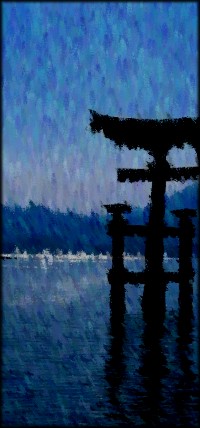 Korobubara,
T'aeru Ko, & Tara Ko
Korobubara,
T'aeru Ko, & Tara Ko
These three towns suffer most in the constant wako raids coming from the direction of the Wako-To islands. While a main part of the livelihoods in Korobubara and T'aeru Ko lie in fishing, part of the share is either extorted by annual marauders or simply taken. Tara Ko is somewhat inland and sheltered by the forest of the same name, but every so often braver pirates will stage an inland sortie. It may seem incongruous for the populace to maintain their dwellings in such troubled places, but many point to the historical flammability of the only other viable option on Makura - Himei has itself burned seven times in the last century. Furthermore, the temples keep the Himei court busy, allowing these three villages autonomy not typical for most communities in Kokubura.
Ironically, members of these towns sometimes serve as pirates themselves when times are bad. If so, they are also eligible for the Wako feat and the Mantis prestige class (Oriental Adventures).
Korobubara
Maps (GIF format): Large (196 kb), Small (92 kb)
Population: 890 (Village)
Gp limit: 1,500 gp
Assets: 3,750 gp
Racial mix: Mixed (92% human, 4% spirit folk, 2% hengeyokai, 2% vanara)
Power center: ConventionalAuthorities:
Mayor Leng Jiffu, human male, Samurai 7, LN
Constable Faryo, human female, Warrior 4, LG
Deputies Bekkyu, Ri, Shimu, Ryowa; Warrior 3, LE
12 town guards (Warrior 2), able to conscript 45 others
Notable NPCs:
Huren, human female, Commoner 6 (merchant), N
Mekkyu Koki, female sea spirit folk, Shugenja 4, CG
Rumori, female human, Expert 4 (blacksmith), NG
Gakota, male human, Expert 3 (barkeep), N
Other NPCs:
Expert 3 (8 people)
Rogue 3 (2 people)
Shaman 2 (1 person)
Commoner 1 (782 people)
Tara Ko
Population: 2120 (Large Town)
Gp limit: 900 gp
Assets: 9,000 tael
Racial mix: Mixed (78% human, 10% spirit folk, 10% vanara, 2% other)
Power center: Conventional (LN)Authorities:
Daimyo Kyokaishen, human male, Samurai 8, LN
Constable Shiroki Dera, female bamboo spirit folk, Warrior 8, LN
Sergeant Gendei Kura, river spirit folk male, Fighter 6, NG
4 Guards, Warrior 3
101 Militia, Warrior 1
Notable NPCs:
Myori, male human, Expert 7, LN (proprietor of dry goods Store)
Arosa, female human, shugenja 5, NG
Ginkoshita Sare, human female, Expert 2 (Proprietor of Suu-wein Tavern and Inn)
Other NPCs:
Shaman 4 (1)
Shaman 2 (2)
Shaman 1 (6)
Shugenja 4 (1)
Shugenja 2 (2)
Fighter 4 (2)
Fighter 2 (4)
Fighter 1 (5)
Expert 3 (2)
Expert 1 (56)
Aristocrat 3 (2)
Commoner 1 (remainder)
Shou-Ken Cloisters
Protected by a stout army of sohei and not a few monks, Shou-Ken Cloisters began as a hermit's dwelling nearly five centuries ago. The position of abbot is said to rotate among three elders who seem neither to age nor die - though perhaps there's more tale than truth to that claim.
Shou-Ken teachings stress a rhythmic pattern of breathing with sudden explosive motions designed to keep the body not only calm but also ready. Their monks are often seen walking serenely around the temple gardens to suddenly lurch into a faster-than-human run, bounding over the walls or whatever stands in their way. At least one visitor has been severely hurt by such unexpected "flying monks."
Practicioners of Shou Ken philosophy who concentrate not only on the martial aspects of the body but also mind occasionally reach a rank called shinsei, which involves taking levels in the shinsei prestige class. Regardless of whether or not they are shinsei, serious followers can take the Shou Ken "Flight" feat.
Shou-Ken Cloisters also supports many minor temples across Makura and perhaps one or two on the main island. While each of these spin-offs will openly swear allegiance to the mother temple, a few have their own agendas, not excluding placing one of their own among the three who determine the sect's policies.
Of note, Mutara Monastery is one of Shou-Ken's more loyal branch temples, and is located behind the main temple a few miles into the mountains. While it does promote religious devotion, it also serves as a front for Shou-ken Cloister's effective ninja training grounds and headquarters. Many pilgrims visit here each year and never suspect its secret. Likewise, spies from Shou-Ken Cloisters are rumored to be able to wield awesome power with simply their minds.
The Mutara elite are called shinkage, meaning "new shadow," and such a rank involves taking levels in the shinkage prestige class.
Shou-ken Cloisters
Population: 1245 (Small town)
Gp limit: 1,200 gp
Assets: 950,000 gp (large for a community of this size, mostly a result of donations)
Racial mix: Mixed (78% human, 12% spirit folk, 7% vanara, 2% hengeyokai, 1% other)
Power center: Religious (Three Masters of Elements, lawful good)
Authorities: First Master (Master of Air, human male, Monk 16, LG), Second Master (Master of Mountains, human female, Shaman 15, LG), Third Master (Master of Wood, bamboo spirit folk, Monk 7/Psion (nomad) 8, LG)
Temple Guard: Makoso, human male, Sohei 8/Shaman 3, LG
Second Guard: Shou-Ken Nokotowi, human female, Sohei 4/Psionic Warrior 4/Shinsei 5, LN
Third Guard: Mutara Mei, human female, Rogue 4/Psion 5 (seer)/Shinkage 5, LG
Notable NPCs:
Gron, male oni, Barbarian 4, N
Shou Ken Mokihei, male bamboo spirit folk, Sohei 7, LG
Terahain, female cat hengeyokai, Fighter 1, N
Shou Ken Joro, male human, Fighter 9 / Weapon Master 3, LN
Shou Ken Showlin ("Shai"), male human, Rogue 6, LN
Gomamo Mikako, female bamboo spirit folk, Samurai 2, LG
Tei, human male, Shaman 8, LG
Tsien Lu-hen, male human, Wu jen 3/Rogue 1, CG
Shi, human male, Monk 8, LN
Taroko, female human, Psychic Warrior 6, LG
Other NPCs:
Adept 8 (3 people), Adept 4 (5 people), Adept 2 (9 people), Adept 1 (20 people)
Aristocrat 4 (2 people)
Commoner 11 (1 person), Commoner 5 (2 people), Commoner 2 (4 people), Commoner 1 (all others)
Expert 10 (1 person, artist/gem cutter), Expert 5 (2 people, weaponsmith, armorer), Expert 2 (4 people), Expert 1 (8 people)
Warrior 7 (3 people), Warrior 3 (26 people), Warrior 1 (40 people)
Sohei 1 (40 people)
Monk 9 (1 person), Monk 7 (1 person), Monk 4 (8 people), Monk 2 (16 people), Monk 1 (28 people)
Shaman 10 (1 person), Shaman 8 (1 person), Shaman 4 (12 people), Shaman 2 (22 people), Shaman 1 (40 people)
Temple Makura
Decendents of the original faithful of the first Kokubura-jin, devotees of Temple Makura have placed their hall of worship beneath the heart of Kura-zan, the volcano housing the spirit of the island.
Makurite asceticism's most notable worship practice is "fire-walking" - though Kura-zan is dormant, there are quite a few places around the mountain where under-earth heat leaks to the surface. In these places, rocks can become so hot they glow, albeit very faintly, at night. Experienced monks of Makura purportedly test their control by walking across specially prepared areas where the rocks reach these high temperatures. There are always, of course tales of those who don't make it - but then who would believe a hobbled old beggar, anyway?
Dedicated followers of Temple Makura are seemingly inured to the damaging effects of fire and can earn the Makuran Fire-Walking feat. The elite are known as Fire Walkers, and to be known as such involves taking levels in the Makuran Fire Walker prestige class.
Makura Temple and Shou-Ken Cloisters share no love, although in the past they have been known to ally together for at least a short time while the Himei daimyo got the upper hand on its religious adversaries. Makura also supports quite a few minor temples throughout the island, and even one in Nigashi, capital of Kokubura. Like the Shou-Ken Cloisters however, Makura Temple seems hard-pressed to keep its juniors in line.
Maps: Typical Makuran temple common in towns across the island Makura (the main temple complex is something quite larger)
Temple Makura
Population: 2,090
Racial mix: Human 90%, fire genasi 6%, other 4%
Alignment: Lawful neutral
Wei Than
The few who have returned from Wei Than tell of a strange place… a small village nested nearly within an open-ended cavern on the northeastern shore of Makura, Wei Than is known to have originated as a retreat for the first priests who ventured from the mainland. Nowadays it sees an eager mix between hengeyokai, humans, and even a few tengu. What this strange mix of creatures is doing in such an isolated area leaves much to the imagination, especially as how the reporters emphasize how luxuriously everyone lived in their everyday lives. What could account for such opulence in this a backwater?
Perhaps owing to its mysteriousness, Wei Than has been implicated in some of the plots known to exist within Makura. It's not known how much truth these suspicions possess, but recently coins with the "Royal Symbol of Wei Than" have been seen in circulation, adding to the talk of secret riches. Were it not for the rugged Ki Mai, surely there would be a race between the warring temples and the daimyo to seize such a treasure chest - if the coins are real, and if the stories are true.
Characters born in Wei Than can take the Aura of Mystique feat.
Wei Than
Population: 2,860
Racial mix: 40% human, 34% hengeyokai, 6% spirit folk, 4% nezumi, 4% tengu, 2% other
Alignment: Neutral good
Waka-to
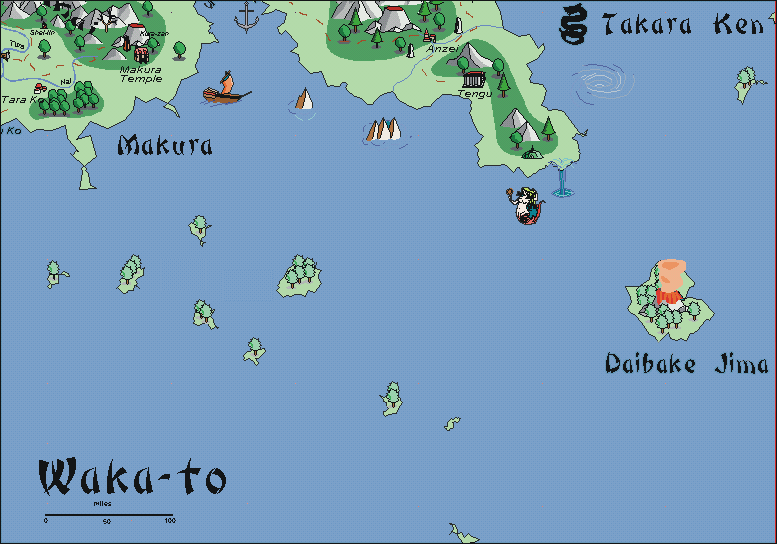
Waka-to is a a collection of islands off the southern eastern coast of Makura. "Waka" is probably a bastardized form of "wako," meaning pirates. Indeed, the coves of these jungle islands harbor their share of communities that prey on Makuran settlements and the mainland-Kokubura trade. Raiding season usually starts in the late summer when harvests are starting to come in, but before the first typhoon can make sea travel perilous. Nevetheless, an increasingly favored tactic is for pirate troupes to ride a typhoon to shore, wait it out, and then take advantage of the confusion to confiscate what they can. Of late, these have become coordinated affairs with relief boats arriving after the storm in case the first one was sunk.
While there seems to be no overriding authority on the islands (wako often compete among each other for spoils), there are rumors that wako princes fund some of the unruly religious institutions on Makura, supposedly to demonstrate to the people how ineffectual their government is. Why such sophisticated political deception would come from bands of pirates remains to be seen.
Perhaps one answer lies in the dissatisfaction some have with the Himei daimyo. While the wako are a great pestilence to the province, it has not been unknown for farmers to ply their agrarian craft most of the season and then take up the sword of the pirate come hard times, only to re-settle when prospects grow brighter.
Notable and notorious wako have taken levels in the Mantis prestige class (Oriental Adventures). Maby also have earned the Wako feat.
Daibake Jima
"Great-monster island" lies at the southern tip of Takara-ken. Abandoned by anyone who values their life, tales of this island come from those frowned upon by fortune, left to live months and years after a shipwreck on an island ruled by the gigantic kaiju. Such survivors, upon returning to civilization, rarely function normally again, as their time living under terror so transformed them.
Due to the great whirlpools at the southern end of Takara-ken, many ships bound for Nigashi pass within sighting distance of the island, though due to the forms of the great monsters which can be seen from shipside, many captains would rather sink than set ashore.
A note on nomenclature: Some of the place names in Kokubura correspond to or are actual Japanese words, but most simply resemble the Japanese language. The reason is that I have lived in Japan and don't like to be reminded of real places while playing a fantasy game -- to the extent that an player with a character in a fantasy medieval setting based on Europe would like to explore "Springfield" or "Kansas City" (not that such campaigns don't exist or aren't good).
